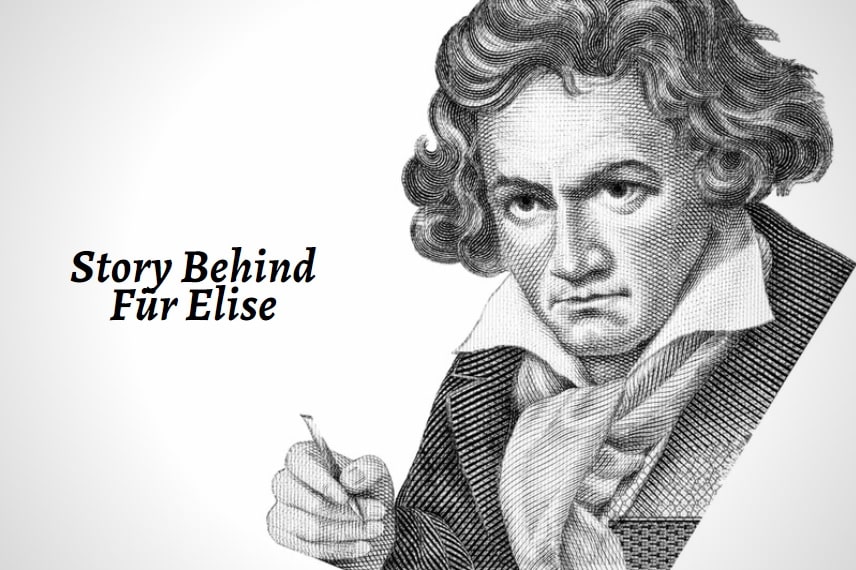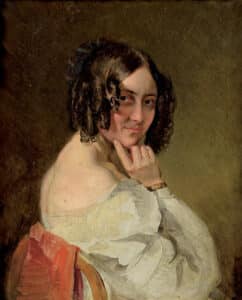
In spite of composing some of the most dramatically beautiful music ever heard, Beethoven’s life was littered with tragedy. Apart from the obvious horror of gradually going deaf, Beethoven did not have much luck with love either. During Beethoven’s brief and troubled life, he fell in love with only a few women and each liaison ended badly for the composer.
Story Behind Für Elise
‘Für Elise’ was in all probability, not the title Beethoven assigned to the piece. What it is, is a ‘Bagatelle’ in the key of A minor, with the catalogue number WoO 59. The likely date of composition is around 1810.
A bagatelle is often thought of as a minor almost trivial piece of music without the musical gravity of a sonata or concerto. Often these light pieces are in rondo form (A B A C A D…), and ‘Für Elise’ follows a similar form: A B A C A with clever variations.
Nevertheless, this appealing bagatelle has attracted almost more attention than many other works by Beethoven.
Part of the mystery that surrounds this piece is not only its title and the implications behind that but also the fact that it was not discovered until over forty years after Beethoven’s death in 1827. The work was published in 1867 and as you might well expect, was immediately popular.
What this means for scholars attempting to unravel the mystery is that tracing evidence of the why’s and when’s of ‘Für Elise’ is made all the more challenging. The man who claimed to have uncovered the original manuscript for the piece was Ludwig Nohl.
Nohl was a German music scholar whose fame these days is only concerning ‘Für Elise’. Unfortunately, this original manuscript was lost, although it’s worth mentioning that some doubt its existence. There is a reason for doubt over the Nohl version of ‘Für Elise’, as there is a later version too.
Musicologist Barry Cooper is credited with having transcribed this later edition and I believe it is now in publication. In the Cooper edition, there are some dramatic changes from the Nohl version that include rhythmic alterations of the accompanying figures and additional bars of music before the ‘B’ section. The reasons why Beethoven may have returned to ‘Für Elise’ around 1822 are unclear.
The title we all know the bagatelle by is ‘Für Elise’, however, this may not have been the title Beethoven gave it. Ludwig Nohl always claimed that he had seen this title on the ‘original’ manuscript that he transcribed but as that is no longer around, we cannot know if this is true.
To add to the curiosity about the title there appears to be scant evidence in Beethoven’s letters and papers he left of anyone called ‘Elise’. This means that what follows is speculative in nature rather than empirical fact.
One of the first names to appear in the list of possible dedicatees is Therese Malfatti. Therese was born into nobility. Her father was a successful merchant. It is thought that Beethoven may have proposed to Therese as she appears to have been the object of his affections.

A letter that dates around May of 1810 certainly supports the claim that Beethoven was in contact with Therese but the tone of the letter is not particularly revealing. What adds a little extra weight to Therese being the Elise in the title is that Beethoven also wrote a song for her that was discovered amongst her belongings after she passed away.
There is also the possibility that Nohl misread the dedication on the manuscript and then incorrectly copied it onto his transcription. Given that this original manuscript is now lost we can’t know but Beethoven’s handwriting was not always neat.
Klaus Martin Kopitz (1955), a German musicologist, jazz musician, and composer hit the headlines with a study published in 2009/10 and another later in 2015 that highlighted the name of Elisabeth Röckel. Elisabeth Röckel was a German soprano whose sister was probably more famous than she was having played a lead role (Florestan), in Beethoven’s ‘Fidelio’.
Elisabeth had been acquainted with Beethoven since the early 1800s and there is much speculation surrounding his intentions towards her; including marriage. Elisabeth decided to marry the well-respected composer Johann Hummel in 1813 which may not have best pleased Beethoven.
What we do know is that Elisabeth had a nickname. According to some sources, Elisabeth was called Elise by her Parish Priest so there may be a tenuous connection there but in the light of the current evidence, I remain sceptical. Kopitz published an English version of his work in 2020 that reportedly has an additional source that supports his claim.
A more recent contender is a lady named Juliane Katherine Elisabet Barensfeld. Her adopted nickname was apparently ‘Elise’. The musicologist Rita Stebin wrote an article in the summer of 2014 Musical Times (Vol.155: No.1927), titled, ‘Who was Beethoven’s “Elise”?’ (A New solution to the mystery).
Stebin suggests in her article that Barensfeld could have been the person Beethoven composed ‘Für Elise’ for.
What we do know about Barensfeld is that she was reportedly a child with an immense musical gift; considered by many to be a prodigy. We also know that she toured and resided with a friend of Beethoven’s, Joseph Nepomuk Mäzel which could have enabled a link to Beethoven.
At seventeen Barensfeld departed from Vienna to join the chamber singers of the Grand Duchess of Baden. From 1820 records of her activities seem to be few. There is also a tenuous connection to Therese Malfatti who lived close to the Mäzel residence.
Stebin goes on to say that perhaps Malfatti may have taught Barensfeld piano and may have suggested to Beethoven that he compose her the famous piece.
As time marches on it may be that scholars unearth the original manuscript or a diary or letter written by Beethoven that sheds new light on the dedicatee of the piece. Until that day comes we are left with the beautiful music that Beethoven composed and an enticing mystery surrounding its title.

Wow, interesting! I learned the piece at the age of 11 and then performed it a year later, I always wanted to know the backstory. It really helps to know these things to properly interpret the meaning and true tone of the wonderful piece